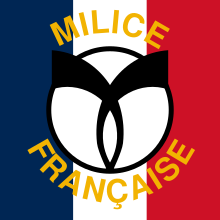Milice française
The Milice française ("French Militia") was a paramilitary force in France during the Second World War . It was in 1943 after the German occupation of all of France called and the subsequent rise of the resistance movement into being and developed by an organization of the Vichy government to independently, with the occupation collaborationist force. There was close cooperation with the German security police (Sipo). The milice pursued political opponents within and helped track down wanted people, especially Jews . The leader of the Milice was the right-wing extremist French politician Aimé-Joseph Darnand , who had made a name for himself in 1936/37 with the violent underground organization Cagoule . At the time of its largest workforce, the militia consisted of 30,000 men, and over the years 45,000 volunteers served there.
history
The war veterans' organization Légion française des combattants had existed since the autumn of 1940 , from which Darnand and high officers of the French army recruited disappointed fighters in the late summer of 1941. In the Alpes-Maritimes department, they founded a secret military organization called the Service d'ordre légionnaire (SOL), which was to be used in the event of further Italian aggression against French territory. By the end of 1941 it had developed into a serious armed force outside the armistice army, which received the official blessing of the Vichy regime in January 1942 to protect France against external and internal aggression.
Towards the end of the summer of 1942, Darnand recruited volunteers for the Légion des volontaires français contre le bolchévisme (LVF, French Volunteer Legion against Bolshevism) or Légion anti-bolchévique or Légion tricolore , where French volunteers in German uniforms fought against the Soviet Union . When it became apparent that in January 1943 militants from the rival collaboration parties Parti populaire français (PPF) and Rassemblement national populaire (RNP) were trying to form combat troops to combat resistance , Darnand restructured the SOL into the Milice française.
Prime Minister Pierre Laval , who saw himself without personal cover in the face of polemical disputes with ultra-collaborationist circles, had obtained Hitler's permission in December 1942 to form a force at his personal disposal. That is why Laval viewed the Milice as his personal defense force, commanded by Darnand, who saw himself primarily as a follower of the aged Marshal Henri Philippe Pétain .
Until the summer of 1943, Laval blocked all submissions after arming the milice. However, as the situation escalated, the Waffen-SS saw the milice as the ideal recruiting field for the formation of a battalion of French Waffen-SS. Ultimately, part of the milice was armed, for which their leadership members had to undertake to recruit new soldiers for the Waffen SS. The Milice was subordinated to the Sipo, which, however, initially prevented Darnand's attempts to expand its field of activity to northern France. She was only allowed to operate in the northern zone from January 1944. It served the Waffen-SS as a useful auxiliary force, primarily in the fight against the Resistance . In addition, Darnand set up the Groupes mobiles de réserve (GMR) and proposed the establishment of a Groupe franc de la garde under his direct control to smash the Maquis of Glières , which was rejected by the head of the SS, SS-Obergruppenführer Carl Oberg .
These mobile, paramilitary units, equipped according to the German model, were mostly composed of very young French people from humble backgrounds, who were characterized by anti-communism and anti-Semitism and received a comparatively high salary . Ideologically , their relatives were oriented towards the recognition of hierarchies , authority and discipline . Overcoming class barriers was seen as more important than capitalism, and active racism was propagated. More than the rest of the collaboration groups, the Milice committed itself to Christian society and respected Catholic traditions. In public campaigns, the Milice took a kind of "crusade stance". Their task was to seize hidden Jews and members of the Resistance and hand them over to the German occupiers. Several thousand Jews were killed in the extermination camps by them . Since the milice was unable to crush the maquis itself, it often limited itself to shooting individual maquisards. Local residents were tortured and killed by the milice on suspicion of supporting the Resistance .
After the liberation of French territory by Allied troops, the milice was dissolved by the provisional government on August 9, 1944. Many leaders and members of the Milice were before military courts tried and convicted some to death.
Art on the subject
- Louis Malle : Lacombe, Lucien (feature film, 1974)
- Louis Malle: Goodbye, Children (feature film, 1987)
- Brian Moore : Hunting (Novel, 1995)
- Norman Jewison : The Statement (feature film, 2003)
- Jean-Paul Salomé : Female Agents - Secret Command Phoenix (Feature Film, 2008)
Web links
Individual evidence
- ^ Text of the order in the French legal database legifrance , accessed on August 8, 2011



